
- Bioactive Compounds
- By Signaling Pathways
- PI3K/Akt/mTOR
- Epigenetics
- Methylation
- Immunology & Inflammation
- Protein Tyrosine Kinase
- Angiogenesis
- Apoptosis
- Autophagy
- ER stress & UPR
- JAK/STAT
- MAPK
- Cytoskeletal Signaling
- Cell Cycle
- TGF-beta/Smad
- Compound Libraries
- Popular Compound Libraries
- Customize Library
- Clinical and FDA-approved Related
- Bioactive Compound Libraries
- Inhibitor Related
- Natural Product Related
- Metabolism Related
- Cell Death Related
- By Signaling Pathway
- By Disease
- Anti-infection and Antiviral Related
- Neuronal and Immunology Related
- Fragment and Covalent Related
- FDA-approved Drug Library
- FDA-approved & Passed Phase I Drug Library
- Preclinical/Clinical Compound Library
- Bioactive Compound Library-I
- Bioactive Compound Library-II
- Kinase Inhibitor Library
- Express-Pick Library
- Natural Product Library
- Human Endogenous Metabolite Compound Library
- Alkaloid Compound LibraryNew
- Angiogenesis Related compound Library
- Anti-Aging Compound Library
- Anti-alzheimer Disease Compound Library
- Antibiotics compound Library
- Anti-cancer Compound Library
- Anti-cancer Compound Library-Ⅱ
- Anti-cancer Metabolism Compound Library
- Anti-Cardiovascular Disease Compound Library
- Anti-diabetic Compound Library
- Anti-infection Compound Library
- Antioxidant Compound Library
- Anti-parasitic Compound Library
- Antiviral Compound Library
- Apoptosis Compound Library
- Autophagy Compound Library
- Calcium Channel Blocker LibraryNew
- Cambridge Cancer Compound Library
- Carbohydrate Metabolism Compound LibraryNew
- Cell Cycle compound library
- CNS-Penetrant Compound Library
- Covalent Inhibitor Library
- Cytokine Inhibitor LibraryNew
- Cytoskeletal Signaling Pathway Compound Library
- DNA Damage/DNA Repair compound Library
- Drug-like Compound Library
- Endoplasmic Reticulum Stress Compound Library
- Epigenetics Compound Library
- Exosome Secretion Related Compound LibraryNew
- FDA-approved Anticancer Drug LibraryNew
- Ferroptosis Compound Library
- Flavonoid Compound Library
- Fragment Library
- Glutamine Metabolism Compound Library
- Glycolysis Compound Library
- GPCR Compound Library
- Gut Microbial Metabolite Library
- HIF-1 Signaling Pathway Compound Library
- Highly Selective Inhibitor Library
- Histone modification compound library
- HTS Library for Drug Discovery
- Human Hormone Related Compound LibraryNew
- Human Transcription Factor Compound LibraryNew
- Immunology/Inflammation Compound Library
- Inhibitor Library
- Ion Channel Ligand Library
- JAK/STAT compound library
- Lipid Metabolism Compound LibraryNew
- Macrocyclic Compound Library
- MAPK Inhibitor Library
- Medicine Food Homology Compound Library
- Metabolism Compound Library
- Methylation Compound Library
- Mouse Metabolite Compound LibraryNew
- Natural Organic Compound Library
- Neuronal Signaling Compound Library
- NF-κB Signaling Compound Library
- Nucleoside Analogue Library
- Obesity Compound Library
- Oxidative Stress Compound LibraryNew
- Plant Extract Library
- Phenotypic Screening Library
- PI3K/Akt Inhibitor Library
- Protease Inhibitor Library
- Protein-protein Interaction Inhibitor Library
- Pyroptosis Compound Library
- Small Molecule Immuno-Oncology Compound Library
- Mitochondria-Targeted Compound LibraryNew
- Stem Cell Differentiation Compound LibraryNew
- Stem Cell Signaling Compound Library
- Natural Phenol Compound LibraryNew
- Natural Terpenoid Compound LibraryNew
- TGF-beta/Smad compound library
- Traditional Chinese Medicine Library
- Tyrosine Kinase Inhibitor Library
- Ubiquitination Compound Library
-
Cherry Picking
You can personalize your library with chemicals from within Selleck's inventory. Build the right library for your research endeavors by choosing from compounds in all of our available libraries.
Please contact us at info@selleckchem.com to customize your library.
You could select:
- Antibodies
- Bioreagents
- qPCR
- 2x SYBR Green qPCR Master Mix
- 2x SYBR Green qPCR Master Mix(Low ROX)
- 2x SYBR Green qPCR Master Mix(High ROX)
- Protein Assay
- Protein A/G Magnetic Beads for IP
- Anti-DYKDDDDK Tag magnetic beads
- Anti-DYKDDDDK Tag Affinity Gel
- Anti-Myc magnetic beads
- Anti-HA magnetic beads
- Poly DYKDDDDK Tag Peptide lyophilized powder
- Protease Inhibitor Cocktail
- Protease Inhibitor Cocktail (EDTA-Free, 100X in DMSO)
- Phosphatase Inhibitor Cocktail (2 Tubes, 100X)
- Cell Biology
- Cell Counting Kit-8 (CCK-8)
- Animal Experiment
- Mouse Direct PCR Kit (For Genotyping)
- New Products
- Contact Us
HSP (HSP90) Inhibitors/Activators | Antagonists | Chemicals | Modulators
HSP (HSP90) Products
- All (63)
- HSP (HSP90) Inhibitors (34)
- HSP (HSP90) Activators (6)
- HSP (HSP90) Antagonist (1)
- HSP (HSP90) Modulators (4)
- New HSP (HSP90) Products
| Cat.No. | Product Name | Information | Product Use Citations | Product Validations |
|---|---|---|---|---|
| S1141 | Tanespimycin (17-AAG) | Tanespimycin (17-AAG, CP127374, NSC-330507, KOS 953) is a potent HSP90 inhibitor with IC50 of 5 nM in a cell-free assay, having a 100-fold higher binding affinity for HSP90 derived from tumour cells than HSP90 from normal cells. It induces apoptosis, necrosis, autophagy and mitophagy. Phase 3. |
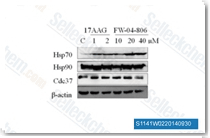
|
|
| S1069 | Luminespib (NVP-AUY922) | Luminespib (AUY-922, NVP-AUY922, VER-52296) is a highly potent HSP90 inhibitor for HSP90α/β with IC50 of 13 nM /21 nM in cell-free assays, exhibits weaker potency against the HSP90 family members GRP94 and TRAP-1, and demonstrates the tightest binding of any small-molecule HSP90 ligand. It effectively downregulates and destabilizes the IGF-1Rβ protein, resulting in growth inhibition, autophagy and apoptosis. Phase 2. |
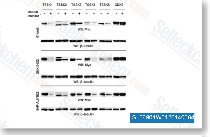
|
|
| S1052 | Elesclomol (STA-4783) | Elesclomol (STA-4783) is a novel potent oxidative stress inducer that elicits pro-apoptosis events among tumor cells. Phase 3.Elesclomol specifically binds ferredoxin 1 (FDX1) α2/α3 helices and β5 strand and inhibits FDX1-mediated Fe-S cluster biosynthesis.Elesclomol (STA-4783) is a potent copper ionophore and can be used in the research of copper-dependent cell death (cuproptosis). |
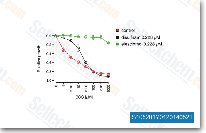
|
|
| S1159 | Ganetespib (STA-9090) | An HSP90 inhibitor with IC50 of 4 nM in OSA 8 cells, Ganetespib (STA-9090) induces apoptosis of OSA cells while normal osteoblasts are not affected; it is an active metabolite of STA-1474. Phase 3. |
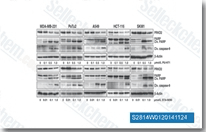
|
|
| S1142 | Alvespimycin (17-DMAG) HCl | Alvespimycin (17-DMAG, NSC 707545, BMS 826476, KOS 1022) HCl is a potent HSP90 inhibitor with IC50 of 62 nM in a cell-free assay. |
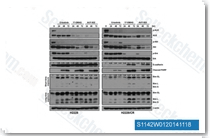
|
|
| S1238 | Tamoxifen | Tamoxifen is an orally active, selective estrogen receptor modulator (SERM) which exhibits both estrogenic agonist and antagonist effects. It blocks estrogen action in breast cells and can activate estrogen activity in other cells, such as bone, liver, and uterine cells. Tamoxifen is a potent Hsp90 activator and enhances the Hsp90 molecular chaperone ATPase activity. |
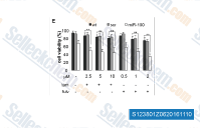
|
|
| S7751 | VER155008 | VER155008 is a potent Hsp70 family inhibitor with IC50 of 0.5 μM, 2.6 μM, and 2.6 μM in cell-free assays for HSP70, HSC70, and GRP78 (HSPA5, Bip), respectively, >100-fold selectivity over HSP90. This compound inhibits autophagy and causes reduced levels of HSP90 client proteins. |
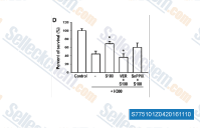
|
|
| S3604 | Triptolide | Triptolide is a diterpene triepoxide, immunosuppresive agent extracted from the Chinese herb Tripterygium wilfordii. It functions as a NF-κB inhibitor with dual actions by disruption of p65/CBP interaction and by reduction of p65 protein. This compound abrogates the transactivation function of heat shock transcription factor 1 (HSF1). It inhibits MDM2 and induces apoptosis through a p53-independent pathway. |
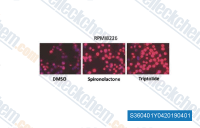
|
|
| S2713 | Geldanamycin | Geldanamycin is a natural existing HSP90 inhibitor with Kd of 1.2 μM, specifically disrupts glucocorticoid receptor (GR)/HSP association. This compound attenuates virus infection-induced ALI (acute lung injury)/ARDS (acute respiratory distress syndrome) by reducing the host's inflammatory responses. |
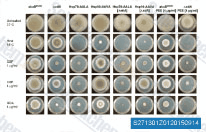
|
|
| S1175 | BIIB021 | BIIB021 (CNF2024) is an orally available, fully synthetic small-molecule inhibitor of HSP90 with Ki and EC50 of 1.7 nM and 38 nM, respectively. Phase 2. |
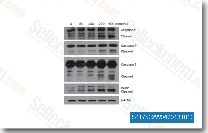
|
|
| S1163 | Onalespib (AT13387) | A selective potent Hsp90 inhibitor with IC50 of 18 nM in A375 cells, Onalespib (AT13387) displays a long duration of anti-tumor activity. Phase 2. |
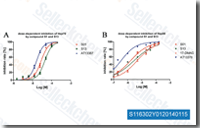
|
|
| S2930 | Pifithrin-μ | Pifithrin-μ (NSC 303580, PFTμ, 2-Phenylethynesulfonamide) is a specific p53 inhibitor by reducing its affinity to Bcl-xL and Bcl-2, and this compound also inhibits HSP70 function and autophagy. |
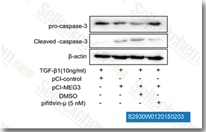
|
|
| S1498 | NVP-BEP800 | NVP-BEP800 (VER82576) is a novel, fully synthetic HSP90β inhibitor with IC50 of 58 nM, exhibits>70-fold selectivity against Hsp90 family members Grp94 and Trap-1. |
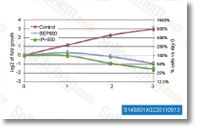
|
|
| S1972 | Tamoxifen Citrate | Tamoxifen Citrate is a selective estrogen receptor modulator (SERM). This compound is also a potent Hsp90 activator and enhances the Hsp90 molecular chaperone ATPase activity. It induces apoptosis and autophagy. |
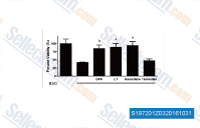
|
|
| S2639 | SNX-2112 | SNX-2112 selectively binds to the ATP pocket of HSP90α and HSP90β with Ka of 30 nM and 30 nM, uniformly more potent than 17-AAG. |
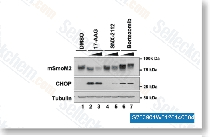
|
|
| S8402 | KRIBB11 | KRIBB11 abolishes the heat shock-induced luciferase activity with an IC50 of 1.2 μM. It is an inhibitor of the transcription factor Heat Shock Factor 1 (HSF1). This compound induces growth arrest and apoptosis. | ||
| S8299 | HA15 | HA15 is a molecule that targets specifically HSPA5 (Heat shock 70kDa protein 5) also known as BiP (Immunoglobulin heavy-chain-binding protein) or Grp78 (glucose-regulated protein 78). This compound displays anti-cancerous activity on all melanoma cells tested, including cells isolated from patients and cells that developed resistance to BRAF inhibitors. |
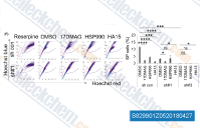
|
|
| S8039 | Zelavespib (PU-H71) | Zelavespib (PU-H71, NSC 750424) is a potent and selective inhibitor of HSP90 with IC50 of 51 nM. This compound is currently in Phase 1. |
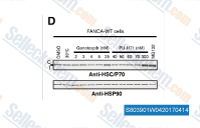
|
|
| S7097 | HSP990 (NVP-HSP990) | HSP990 (NVP-HSP990) is a novel, potent and selective HSP90 inhibitor for HSP90α/β with IC50 of 0.6 nM/0.8 nM, and it induces cell cycle arrest and apoptosis. |
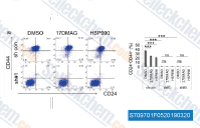
|
|
| S7282 | NMS-E973 | NMS-E973 is a potent and selective Hsp90 inhibitor with DC50 of <10 nM for Hsp90 binding, no activiy against a panel of 52 diverse protein kinases. |
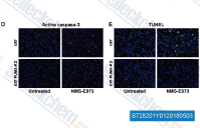
|
|
| S8365 | Apoptozole | Apoptozole (Apoptosis Activator VII) is an inhibitor of heat shock protein 70(HSP70) and Hsc70 with dissociation constants Kd of 0.14 μM and 0.21 μM, respectively. It induces caspase-dependent apoptosis. |
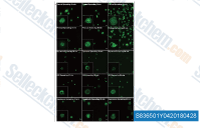
|
|
| S7122 | XL888 | XL888 is an ATP-competitive inhibitor of HSP90 with IC50 of 24 nM. Phase 1. |
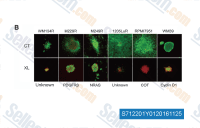
|
|
| S2656 | PF-04929113 (SNX-5422) | A potent and selective HSP90 inhibitor, PF-04929113 (SNX-5422) has a Kd of 41 nM and induces Her-2 degradation with an IC50 of 37 nM. Phase 1/2. |
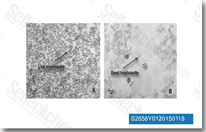
|
|
| S7750 | KNK437 | KNK437 is a pan-HSP inhibitor, which inhibits the synthesis of inducible HSPs, including HSP105, HSP72, and HSP40. |
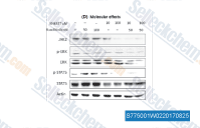
|
|
| S5006 | Teprenone | Teprenone, an acylic polyisoprenoid, that is known as tetraprenylacetone or geranylgeranylacetone, is an anti-ulcer drug, clinically used for gastritis. This compound is an inducer of heat shock proteins (HSPs) expression. | ||
| S8305 | TRC051384 | TRC051384 is an inducer of heat shock protein 70 (HSP70) and potent anti-inflammatory agent. | ||
| S7459 | VER-50589 | VER-50589 is a potent HSP90 inhibitor with IC50 of 21 nM for HSP90β. | ||
| S7428 | Rocaglamide | Rocaglamide (Roc-A), isolated from Aglaia species, is a potent inhibitor of heat shock factor 1 (HSF1) activation with IC50 of ~50 nM for HSF1. This compound inhibits the function of the translation initiation factor eIF4A. It also inhibits NF-κB activity. This chemical exhibits anti-tumor activity. | ||
| S7458 | VER-49009 | VER-49009 (CCT0129397) is a potent HSP90 inhibitor with IC50 of 47 nM for HSP90β. | ||
| S7716 | Pimitespib (TAS-116) | A novel, small-molecule HSP90 inhibitor, Pimitespib (TAS-116) inhibits geldanamycin-FITC binding to HSP90 proteins with Ki values of 34.7 nmol/L, 21.3 nmol/L, >50,000 nmol/L, and >50,000 nmol/L for HSP90α, HSP90β, GRP94, and TRAP1, respectively. Furthermore, it does not inhibit other ATPases such as HSP70 (IC50 >200 μmol/L). | ||
| S6721 | JG98 | JG-98 is an allosteric inhibitor of Hsp70 that binds tightly to a deep pocket that is conserved in members of the Hsp70 family. JG-98 induces classical apoptosis features, including morphological changes consistent with programmed cell death and positive annexin staining. JG-98 exhibits anticancer activity. | ||
| S2685 | KW-2478 | KW-2478 is a nonansamycin HSP90 inhibitor with IC50 of 3.8 nM. Phase 1. | ||
| S0279 | Dimethylenastron | Dimethylenastron is a potent, specific and reversible inhibitor of kinesin Eg5 (kinesin-5/kinesin spindle protein, KSP) with IC50 of 200 nM. This compound induces mitotic arrest and apoptosis and upregulate Hsp70 in human multiple myeloma cells. | ||
| S9806 | DTHIB | DTHIB (Direct Targeted HSF1 InhiBitor) is a direct and selective inhibitor of heat shock factor 1 (HSF1) with Kd of 160 nM for this compound binding to the HSF1 DNA binding domain (DBD). This compound exhibits potently anticancer activities. | ||
| F1607 | Hsp70 Antibody [C13L16] | Heat Shock Protein 70,HSP 70,Hsp70 | ||
| F2702New | GRP78/BIP Antibody [N15D19] | BiP,BiP/GRP78,GRP78 BiP,GRP78/HSPA5,HSPA5,HSPA5/BiP/GRP78 | ||
| F0889 | HSP90α Antibody [G3M5] | Hsp90 alpha,HSP90α | ||
| F1132 | Hsp90 β Antibody [J8A2] | Heat shock protein HSP 90-beta, Heat shock protein HSP 90 β, HSP 90, Heat shock 84 kDa , HSP 84, HSP84, Heat shock protein family C member 3, HSP90AB1, HSP90B, HSPC2, HSPC3, HSPCB, Heat shock protein HSP 90-alpha, Heat shock protein HSP 90 α, Heat shock 86 kDa, HSP 86, HSP86, Heat shock protein family C member 1, Lipopolysaccharide-associated protein 2, LAP-2, LPS-associated protein 2, Renal carcinoma antigen NY-REN-38 | ||
| F0221 | GRP78/BIP Antibody [J10G21] | BiP,BiP/GRP78,GRP78 BiP,GRP78/HSPA5,HSPA5,HSPA5/BiP/GRP78 | ||
| F0482 | HSP60 Antibody [G1B22] | Heat Shock Protein 60,HSP 60,HSP60 | ||
| F0283New | HSP90 Antibody [L2G2] | Heat Shock Protein 90,HSP90,HSP90 alpha/beta | ||
| F1064 | HSPA8/HSC70 Antibody [A13M15] | Hsc70,HSPA8,HSPA8/HSC70,HSPA8/HSC71/Hsc70 | ||
| F2537New | Hsc70 Antibody [K23K6] | Hsc70,HSPA8,HSPA8/HSC70,HSPA8/HSC71/Hsc70 | ||
| F1368 | Grp94 Antibody [H14G20] | |||
| F1381 | HSF1 Antibody [D20H1] | |||
| F0750 | Phospho-HSP27 (Ser82) Antibody [J19L2] | Hsp27 (phospho S82),Phospho-HSP27 (Ser82),Phospho-HSP27 (Ser82) II | ||
| F1336 | HSP40 Antibody [K10K22] | |||
| F3013New | HSP27 Antibody [P9K18] | HSP 27,HSP27 | ||
| F2753New | HSPA2 Antibody [C14M13] | |||
| F2186 | Hsp47 Antibody [P19M10] | Hsp47,HSP47/SERPINH1 | ||
| S0294 | HSF1A | HSF1A is a cell-permeable heat shock transcription factor 1 (HSF1) activator. This compound protects cells from stress-induced apoptosis, binds TRiC subunits and inhibits TRiC activity without perturbation of ATP hydrolysis. | ||
| F0607New | SRC-3 Antibody [C6H19] | SRC3,SRC-3 | ||
| S6568 | ML346 | ML346 is a Hsp70 activator and a novel modulator of proteostasis for protein conformational diseases. | ||
| E0362 | BiP Inducer X (BIX) | BiP Inducer X (BIX) is a selective GRP78 (BiP, HSPA5) inducer. It induces BiP only, in a dose-dependent manner, without induction of other molecules involved in the ER stress response. |
||
| E4678New | EZH2/HSP90-IN-29 | EZH2/HSP90-IN-29 is a potent dual inhibitor of EZH2 and HSP90, with IC50s of 6.29 nM and 60.1 nM, for EZH2 and HSP90, respectively, that induces M-phase cell cycle arrest, promotes apoptosis/necrosis-related gene expression, and inhibits ROS catabolism. It crosses the blood-brain barrier and can show potential as a tractable anti-GBM agent for glioblastoma research. | ||
| E0249 | Pseudolaric Acid A | Pseudolaric acid A, a Hsp90 inhibitor with an IC50 of 0.60 μM, 2.72 μM, 1.36 μM, 2.92 μM and 6.16 μM in HL-60, A549, SMMC-7721, HeLa and SW480 cells respectively, is the main bioactive ingredient in Pseudolarix cortex, and induces cell cycle arrest at G2/M phase and promotes cell death through caspase-8/caspase-3 pathway, demonstrating potent antiproliferation and anticancer activities. | ||
| E7068New | Novobiocin | Novobiocin (Albamycin, Cathomycin) is a potent, orally active antibiotic and an inhibitor of DNA gyrase andtopoisomerase II, and also an antagonist of heat shock protein 90 (Hsp90). It shows potential for treating β-lactam-resistant pneumococcal infections and sensitizing brain tumors to DNA cross-linking anticancer agents. | ||
| S7340 | CH5138303 | CH5138303 is an orally available Hsp90 inhibitor with Kd of 0.48 nM. | ||
| E5996New | Col003 | Col003 is a potent inhibitor of Hsp47 that competitively binds to the collagen-binding site on Hsp47 and inhibited the interaction between Hsp47 and collagen with an IC50 of 1.8 μM. It can be used in research as a potential lead compound for the treatment of fibrosis. | ||
| S6193 | YUM70 | YUM70 is a potent inhibitor of glucose-regulated protein 78 (GRP78) inhibitor with an IC50 of 1.5 μM. This compound induces endoplasmic reticulum (ER) stress-mediated apoptosis in pancreatic cancer.Although this chemical inhibits GRP78 enzymatic activity, it increases the expression of GRP78 by increasing the chaperone translation mechanism. | ||
| E0701 | Cucurbitacin D | Cucurbitacin D is an active component in Cucurbita texana, disrupts maturation of HSP90 and interactions between Hsp90 and two co-chaperones, Cdc37 and p23. | ||
| S3404 | HSP27 inhibitor J2 | HSP27 inhibitor J2 (J2) is an inhibitor of HSP27, which induces abnormal HSP27 dimers formation and suppresses the generation of HSP27 giant polymers, inhibiting the chaperone role of HSP27 and diminishing its cellular protective function. This compound enhances the antiproliferative activity of 17-AAG and increases the sensitivity of cisplatin-induced lung cancer cell growth inhibition. | ||
| E1208 | NPX800 | NPX800 is a potent heat shock factor 1 (HSF1) inhibitor, which has the potential for cancer research. | ||
| S1141 | Tanespimycin (17-AAG) | Tanespimycin (17-AAG, CP127374, NSC-330507, KOS 953) is a potent HSP90 inhibitor with IC50 of 5 nM in a cell-free assay, having a 100-fold higher binding affinity for HSP90 derived from tumour cells than HSP90 from normal cells. It induces apoptosis, necrosis, autophagy and mitophagy. Phase 3. |

|
|
| S1069 | Luminespib (NVP-AUY922) | Luminespib (AUY-922, NVP-AUY922, VER-52296) is a highly potent HSP90 inhibitor for HSP90α/β with IC50 of 13 nM /21 nM in cell-free assays, exhibits weaker potency against the HSP90 family members GRP94 and TRAP-1, and demonstrates the tightest binding of any small-molecule HSP90 ligand. It effectively downregulates and destabilizes the IGF-1Rβ protein, resulting in growth inhibition, autophagy and apoptosis. Phase 2. |

|
|
| S1159 | Ganetespib (STA-9090) | An HSP90 inhibitor with IC50 of 4 nM in OSA 8 cells, Ganetespib (STA-9090) induces apoptosis of OSA cells while normal osteoblasts are not affected; it is an active metabolite of STA-1474. Phase 3. |

|
|
| S1142 | Alvespimycin (17-DMAG) HCl | Alvespimycin (17-DMAG, NSC 707545, BMS 826476, KOS 1022) HCl is a potent HSP90 inhibitor with IC50 of 62 nM in a cell-free assay. |

|
|
| S7751 | VER155008 | VER155008 is a potent Hsp70 family inhibitor with IC50 of 0.5 μM, 2.6 μM, and 2.6 μM in cell-free assays for HSP70, HSC70, and GRP78 (HSPA5, Bip), respectively, >100-fold selectivity over HSP90. This compound inhibits autophagy and causes reduced levels of HSP90 client proteins. |

|
|
| S3604 | Triptolide | Triptolide is a diterpene triepoxide, immunosuppresive agent extracted from the Chinese herb Tripterygium wilfordii. It functions as a NF-κB inhibitor with dual actions by disruption of p65/CBP interaction and by reduction of p65 protein. This compound abrogates the transactivation function of heat shock transcription factor 1 (HSF1). It inhibits MDM2 and induces apoptosis through a p53-independent pathway. |

|
|
| S2713 | Geldanamycin | Geldanamycin is a natural existing HSP90 inhibitor with Kd of 1.2 μM, specifically disrupts glucocorticoid receptor (GR)/HSP association. This compound attenuates virus infection-induced ALI (acute lung injury)/ARDS (acute respiratory distress syndrome) by reducing the host's inflammatory responses. |

|
|
| S1175 | BIIB021 | BIIB021 (CNF2024) is an orally available, fully synthetic small-molecule inhibitor of HSP90 with Ki and EC50 of 1.7 nM and 38 nM, respectively. Phase 2. |

|
|
| S1163 | Onalespib (AT13387) | A selective potent Hsp90 inhibitor with IC50 of 18 nM in A375 cells, Onalespib (AT13387) displays a long duration of anti-tumor activity. Phase 2. |

|
|
| S2930 | Pifithrin-μ | Pifithrin-μ (NSC 303580, PFTμ, 2-Phenylethynesulfonamide) is a specific p53 inhibitor by reducing its affinity to Bcl-xL and Bcl-2, and this compound also inhibits HSP70 function and autophagy. |

|
|
| S1498 | NVP-BEP800 | NVP-BEP800 (VER82576) is a novel, fully synthetic HSP90β inhibitor with IC50 of 58 nM, exhibits>70-fold selectivity against Hsp90 family members Grp94 and Trap-1. |

|
|
| S2639 | SNX-2112 | SNX-2112 selectively binds to the ATP pocket of HSP90α and HSP90β with Ka of 30 nM and 30 nM, uniformly more potent than 17-AAG. |

|
|
| S8402 | KRIBB11 | KRIBB11 abolishes the heat shock-induced luciferase activity with an IC50 of 1.2 μM. It is an inhibitor of the transcription factor Heat Shock Factor 1 (HSF1). This compound induces growth arrest and apoptosis. | ||
| S8039 | Zelavespib (PU-H71) | Zelavespib (PU-H71, NSC 750424) is a potent and selective inhibitor of HSP90 with IC50 of 51 nM. This compound is currently in Phase 1. |

|
|
| S7097 | HSP990 (NVP-HSP990) | HSP990 (NVP-HSP990) is a novel, potent and selective HSP90 inhibitor for HSP90α/β with IC50 of 0.6 nM/0.8 nM, and it induces cell cycle arrest and apoptosis. |

|
|
| S7282 | NMS-E973 | NMS-E973 is a potent and selective Hsp90 inhibitor with DC50 of <10 nM for Hsp90 binding, no activiy against a panel of 52 diverse protein kinases. |

|
|
| S8365 | Apoptozole | Apoptozole (Apoptosis Activator VII) is an inhibitor of heat shock protein 70(HSP70) and Hsc70 with dissociation constants Kd of 0.14 μM and 0.21 μM, respectively. It induces caspase-dependent apoptosis. |

|
|
| S7122 | XL888 | XL888 is an ATP-competitive inhibitor of HSP90 with IC50 of 24 nM. Phase 1. |

|
|
| S2656 | PF-04929113 (SNX-5422) | A potent and selective HSP90 inhibitor, PF-04929113 (SNX-5422) has a Kd of 41 nM and induces Her-2 degradation with an IC50 of 37 nM. Phase 1/2. |

|
|
| S7750 | KNK437 | KNK437 is a pan-HSP inhibitor, which inhibits the synthesis of inducible HSPs, including HSP105, HSP72, and HSP40. |

|
|
| S7459 | VER-50589 | VER-50589 is a potent HSP90 inhibitor with IC50 of 21 nM for HSP90β. | ||
| S7428 | Rocaglamide | Rocaglamide (Roc-A), isolated from Aglaia species, is a potent inhibitor of heat shock factor 1 (HSF1) activation with IC50 of ~50 nM for HSF1. This compound inhibits the function of the translation initiation factor eIF4A. It also inhibits NF-κB activity. This chemical exhibits anti-tumor activity. | ||
| S7458 | VER-49009 | VER-49009 (CCT0129397) is a potent HSP90 inhibitor with IC50 of 47 nM for HSP90β. | ||
| S7716 | Pimitespib (TAS-116) | A novel, small-molecule HSP90 inhibitor, Pimitespib (TAS-116) inhibits geldanamycin-FITC binding to HSP90 proteins with Ki values of 34.7 nmol/L, 21.3 nmol/L, >50,000 nmol/L, and >50,000 nmol/L for HSP90α, HSP90β, GRP94, and TRAP1, respectively. Furthermore, it does not inhibit other ATPases such as HSP70 (IC50 >200 μmol/L). | ||
| S6721 | JG98 | JG-98 is an allosteric inhibitor of Hsp70 that binds tightly to a deep pocket that is conserved in members of the Hsp70 family. JG-98 induces classical apoptosis features, including morphological changes consistent with programmed cell death and positive annexin staining. JG-98 exhibits anticancer activity. | ||
| S2685 | KW-2478 | KW-2478 is a nonansamycin HSP90 inhibitor with IC50 of 3.8 nM. Phase 1. | ||
| S9806 | DTHIB | DTHIB (Direct Targeted HSF1 InhiBitor) is a direct and selective inhibitor of heat shock factor 1 (HSF1) with Kd of 160 nM for this compound binding to the HSF1 DNA binding domain (DBD). This compound exhibits potently anticancer activities. | ||
| E4678New | EZH2/HSP90-IN-29 | EZH2/HSP90-IN-29 is a potent dual inhibitor of EZH2 and HSP90, with IC50s of 6.29 nM and 60.1 nM, for EZH2 and HSP90, respectively, that induces M-phase cell cycle arrest, promotes apoptosis/necrosis-related gene expression, and inhibits ROS catabolism. It crosses the blood-brain barrier and can show potential as a tractable anti-GBM agent for glioblastoma research. | ||
| E0249 | Pseudolaric Acid A | Pseudolaric acid A, a Hsp90 inhibitor with an IC50 of 0.60 μM, 2.72 μM, 1.36 μM, 2.92 μM and 6.16 μM in HL-60, A549, SMMC-7721, HeLa and SW480 cells respectively, is the main bioactive ingredient in Pseudolarix cortex, and induces cell cycle arrest at G2/M phase and promotes cell death through caspase-8/caspase-3 pathway, demonstrating potent antiproliferation and anticancer activities. | ||
| S7340 | CH5138303 | CH5138303 is an orally available Hsp90 inhibitor with Kd of 0.48 nM. | ||
| E5996New | Col003 | Col003 is a potent inhibitor of Hsp47 that competitively binds to the collagen-binding site on Hsp47 and inhibited the interaction between Hsp47 and collagen with an IC50 of 1.8 μM. It can be used in research as a potential lead compound for the treatment of fibrosis. | ||
| S6193 | YUM70 | YUM70 is a potent inhibitor of glucose-regulated protein 78 (GRP78) inhibitor with an IC50 of 1.5 μM. This compound induces endoplasmic reticulum (ER) stress-mediated apoptosis in pancreatic cancer.Although this chemical inhibits GRP78 enzymatic activity, it increases the expression of GRP78 by increasing the chaperone translation mechanism. | ||
| S3404 | HSP27 inhibitor J2 | HSP27 inhibitor J2 (J2) is an inhibitor of HSP27, which induces abnormal HSP27 dimers formation and suppresses the generation of HSP27 giant polymers, inhibiting the chaperone role of HSP27 and diminishing its cellular protective function. This compound enhances the antiproliferative activity of 17-AAG and increases the sensitivity of cisplatin-induced lung cancer cell growth inhibition. | ||
| E1208 | NPX800 | NPX800 is a potent heat shock factor 1 (HSF1) inhibitor, which has the potential for cancer research. | ||
| S1238 | Tamoxifen | Tamoxifen is an orally active, selective estrogen receptor modulator (SERM) which exhibits both estrogenic agonist and antagonist effects. It blocks estrogen action in breast cells and can activate estrogen activity in other cells, such as bone, liver, and uterine cells. Tamoxifen is a potent Hsp90 activator and enhances the Hsp90 molecular chaperone ATPase activity. |

|
|
| S1972 | Tamoxifen Citrate | Tamoxifen Citrate is a selective estrogen receptor modulator (SERM). This compound is also a potent Hsp90 activator and enhances the Hsp90 molecular chaperone ATPase activity. It induces apoptosis and autophagy. |

|
|
| S0279 | Dimethylenastron | Dimethylenastron is a potent, specific and reversible inhibitor of kinesin Eg5 (kinesin-5/kinesin spindle protein, KSP) with IC50 of 200 nM. This compound induces mitotic arrest and apoptosis and upregulate Hsp70 in human multiple myeloma cells. | ||
| S0294 | HSF1A | HSF1A is a cell-permeable heat shock transcription factor 1 (HSF1) activator. This compound protects cells from stress-induced apoptosis, binds TRiC subunits and inhibits TRiC activity without perturbation of ATP hydrolysis. | ||
| S6568 | ML346 | ML346 is a Hsp70 activator and a novel modulator of proteostasis for protein conformational diseases. | ||
| E0362 | BiP Inducer X (BIX) | BiP Inducer X (BIX) is a selective GRP78 (BiP, HSPA5) inducer. It induces BiP only, in a dose-dependent manner, without induction of other molecules involved in the ER stress response. |
||
| E7068New | Novobiocin | Novobiocin (Albamycin, Cathomycin) is a potent, orally active antibiotic and an inhibitor of DNA gyrase andtopoisomerase II, and also an antagonist of heat shock protein 90 (Hsp90). It shows potential for treating β-lactam-resistant pneumococcal infections and sensitizing brain tumors to DNA cross-linking anticancer agents. | ||
| S1052 | Elesclomol (STA-4783) | Elesclomol (STA-4783) is a novel potent oxidative stress inducer that elicits pro-apoptosis events among tumor cells. Phase 3.Elesclomol specifically binds ferredoxin 1 (FDX1) α2/α3 helices and β5 strand and inhibits FDX1-mediated Fe-S cluster biosynthesis.Elesclomol (STA-4783) is a potent copper ionophore and can be used in the research of copper-dependent cell death (cuproptosis). |

|
|
| S8299 | HA15 | HA15 is a molecule that targets specifically HSPA5 (Heat shock 70kDa protein 5) also known as BiP (Immunoglobulin heavy-chain-binding protein) or Grp78 (glucose-regulated protein 78). This compound displays anti-cancerous activity on all melanoma cells tested, including cells isolated from patients and cells that developed resistance to BRAF inhibitors. |

|
|
| S8305 | TRC051384 | TRC051384 is an inducer of heat shock protein 70 (HSP70) and potent anti-inflammatory agent. | ||
| E0701 | Cucurbitacin D | Cucurbitacin D is an active component in Cucurbita texana, disrupts maturation of HSP90 and interactions between Hsp90 and two co-chaperones, Cdc37 and p23. | ||
| F2702New | GRP78/BIP Antibody [N15D19] | BiP,BiP/GRP78,GRP78 BiP,GRP78/HSPA5,HSPA5,HSPA5/BiP/GRP78 | ||
| F0283New | HSP90 Antibody [L2G2] | Heat Shock Protein 90,HSP90,HSP90 alpha/beta | ||
| F2537New | Hsc70 Antibody [K23K6] | Hsc70,HSPA8,HSPA8/HSC70,HSPA8/HSC71/Hsc70 | ||
| F3013New | HSP27 Antibody [P9K18] | HSP 27,HSP27 | ||
| F2753New | HSPA2 Antibody [C14M13] | |||
| F0607New | SRC-3 Antibody [C6H19] | SRC3,SRC-3 | ||
| E4678New | EZH2/HSP90-IN-29 | EZH2/HSP90-IN-29 is a potent dual inhibitor of EZH2 and HSP90, with IC50s of 6.29 nM and 60.1 nM, for EZH2 and HSP90, respectively, that induces M-phase cell cycle arrest, promotes apoptosis/necrosis-related gene expression, and inhibits ROS catabolism. It crosses the blood-brain barrier and can show potential as a tractable anti-GBM agent for glioblastoma research. | ||
| E7068New | Novobiocin | Novobiocin (Albamycin, Cathomycin) is a potent, orally active antibiotic and an inhibitor of DNA gyrase andtopoisomerase II, and also an antagonist of heat shock protein 90 (Hsp90). It shows potential for treating β-lactam-resistant pneumococcal infections and sensitizing brain tumors to DNA cross-linking anticancer agents. | ||
| E5996New | Col003 | Col003 is a potent inhibitor of Hsp47 that competitively binds to the collagen-binding site on Hsp47 and inhibited the interaction between Hsp47 and collagen with an IC50 of 1.8 μM. It can be used in research as a potential lead compound for the treatment of fibrosis. |






































